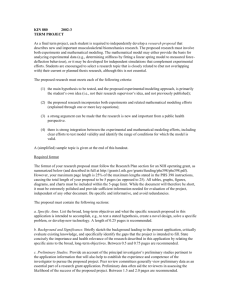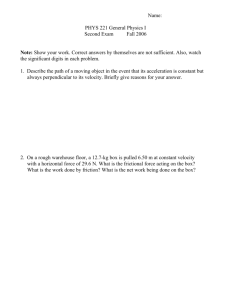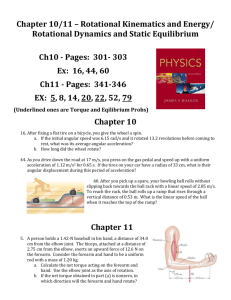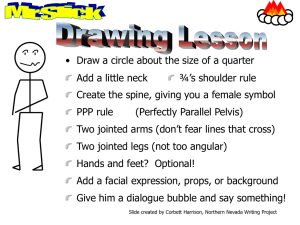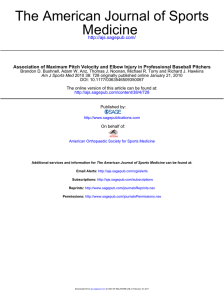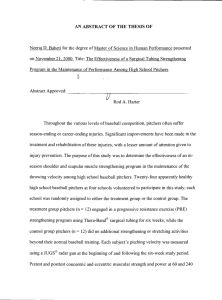to read review - Kenny maurer
advertisement
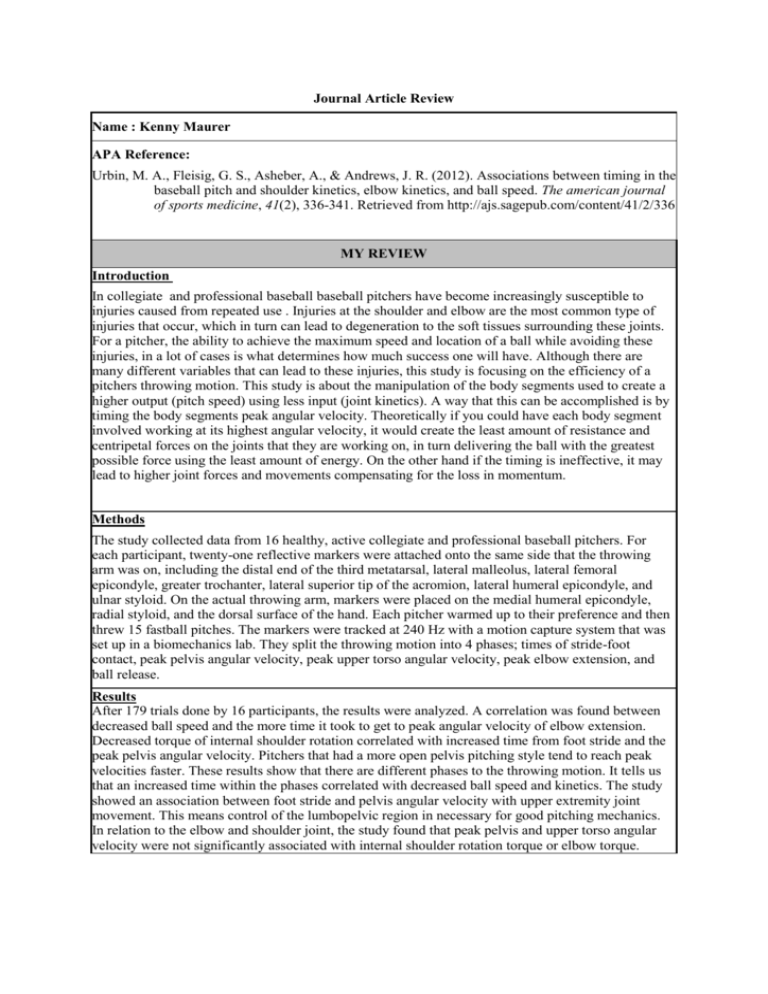
Journal Article Review Name : Kenny Maurer APA Reference: Urbin, M. A., Fleisig, G. S., Asheber, A., & Andrews, J. R. (2012). Associations between timing in the baseball pitch and shoulder kinetics, elbow kinetics, and ball speed. The american journal of sports medicine, 41(2), 336-341. Retrieved from http://ajs.sagepub.com/content/41/2/336 MY REVIEW Introduction In collegiate and professional baseball baseball pitchers have become increasingly susceptible to injuries caused from repeated use . Injuries at the shoulder and elbow are the most common type of injuries that occur, which in turn can lead to degeneration to the soft tissues surrounding these joints. For a pitcher, the ability to achieve the maximum speed and location of a ball while avoiding these injuries, in a lot of cases is what determines how much success one will have. Although there are many different variables that can lead to these injuries, this study is focusing on the efficiency of a pitchers throwing motion. This study is about the manipulation of the body segments used to create a higher output (pitch speed) using less input (joint kinetics). A way that this can be accomplished is by timing the body segments peak angular velocity. Theoretically if you could have each body segment involved working at its highest angular velocity, it would create the least amount of resistance and centripetal forces on the joints that they are working on, in turn delivering the ball with the greatest possible force using the least amount of energy. On the other hand if the timing is ineffective, it may lead to higher joint forces and movements compensating for the loss in momentum. Methods The study collected data from 16 healthy, active collegiate and professional baseball pitchers. For each participant, twenty-one reflective markers were attached onto the same side that the throwing arm was on, including the distal end of the third metatarsal, lateral malleolus, lateral femoral epicondyle, greater trochanter, lateral superior tip of the acromion, lateral humeral epicondyle, and ulnar styloid. On the actual throwing arm, markers were placed on the medial humeral epicondyle, radial styloid, and the dorsal surface of the hand. Each pitcher warmed up to their preference and then threw 15 fastball pitches. The markers were tracked at 240 Hz with a motion capture system that was set up in a biomechanics lab. They split the throwing motion into 4 phases; times of stride-foot contact, peak pelvis angular velocity, peak upper torso angular velocity, peak elbow extension, and ball release. Results After 179 trials done by 16 participants, the results were analyzed. A correlation was found between decreased ball speed and the more time it took to get to peak angular velocity of elbow extension. Decreased torque of internal shoulder rotation correlated with increased time from foot stride and the peak pelvis angular velocity. Pitchers that had a more open pelvis pitching style tend to reach peak velocities faster. These results show that there are different phases to the throwing motion. It tells us that an increased time within the phases correlated with decreased ball speed and kinetics. The study showed an association between foot stride and pelvis angular velocity with upper extremity joint movement. This means control of the lumbopelvic region in necessary for good pitching mechanics. In relation to the elbow and shoulder joint, the study found that peak pelvis and upper torso angular velocity were not significantly associated with internal shoulder rotation torque or elbow torque. Critique This journal article included detailed results about pitching speed and how it correlates pitching mechanics to ball speed. In the end they were looking for the most efficient movements. Even though increased time within specific phases correlates with a decrease ball speeds, it also affects the amount of upper extremity kinetics that are associated with injuries from overuse. Like everything there will always be a give or take but it is within the best interest of a player to have a longer career then and injury prone one. The point of the study was to find the optimal balance in timing to create a maximum ball speed while having the smallest amount of risk for a player. There were conflicting results between this study and another one that they were comparing too. The other study, (Influence of pelvis rotation styles on baseball pitching mechanics, wight j), found that an open pelvis orientation showed less shoulder distractive force, shoulder internal rotation torque, and elbow torque when there was less time between each phase of the cycle. Conflicting reasoning could have resulted from differences in the design of studies. wight, looked at 3 difference types of pitches while this one only looked at one type of pitch. The data does not contradict what they are saying in the study but does contradict other studies of its kind. It remains unknown exactly how much of each pitching phase needs to be decreased for a pitcher to benefit from the technique. They only gave a general idea for all pitching styles. So much can depend on the individual athlete and his/her prior history to injuries and pitching mechanics. A future study could improve this information by putting this research to test. If each pitcher was to be individually trained and monitored to change their style and studied over a longer period of time, to see the implications of this body of work.
